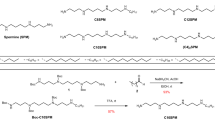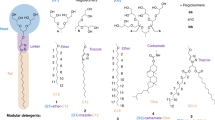Abstract
Myristylation often governs the targeting of protein kinases to the plasma membrane. It is now known that a key member of the src family of protein tyrosine kinases, pp60v-src, binds to the lipid bilayer of the plasma membrane via a myristylated amino terminal sequence. The mechanism of this interaction is not known; however, myristic acid (Myristic acid may also be referred to as Myristate) and residues 2 through 14 are also absolutely required (Resh and Ling, 1990). This review presents an analysis of crystal structures of detergent-modified recombinant and myristylated mammalian catalytic subunit of protein kinase A. Crystals of unmyristylated recombinant catalytic subunit of protein kinase A are grown in the presence of Mega 8, a glucamide-type of detergent, and only this detergent binds, which results in a resolution extension (Knightonet al., 1991a). Comparisons of these two structures reveal that the detergent association with the recombinant enzyme binds in exactly the same hydrophobic pocket of the protein occupied by myristic acid in the mammalian protein (Karlssonet al., 1993; Zhenget al., 1993a). Removal of the detergent through soaking results in the local unwinding of the first helix, helix A, and disorder of the canonical recognition sequence of the phosphorylation site, Ser 10 (Zhenget al., 1993b). These results suggest that anchoring the myristic acid inside the protein results in formation of a stable structural template, which includes the myristylated amino terminal sequence important for the recognition by protein kinases. This “inside out” motif might provide a structural paradigm for the recognition of myristylated proteins, including pp60v-src.
Similar content being viewed by others
References
Bossemeyer, D., Engh, R. A., Kinzel, V., Ponstingl, H., and Huber, R. (1993).EMBO J. 12, 849–859.
Brooks-Wilson, A. R., Ball, E., and Pawson, T. (1989).Mol. Cell. Biol. 9, 2214–2219.
Chow, M., Newman, J. F. E., Filman, D., Hogle, J. M., Rowlands D. J., and Brown, F. (1987).Nature 327, 482–486.
Cross, F. R., Garber, E. A., Pellman, D., and Hanafusa, H. (1984).Mol. Cell. Biol. 4, 1834–1842.
De Bondt, H. L., Rosennlatt, J., Jancarik, J., Jones, H. D., Morgan, D. O., and Kim, S. H. (1993).Nature 363, 595–602.
Garber, E. A., Cross, F. R., and Hanafusa, H. (1985).Mol. Cell. Biol. 5, 2781–2788.
Hanks, S., and Quinn, A. M. (1991). InProtein Phosphorylation (Part A) (Hunter, T., and Sefton, B. M., eds.), Academic Press, San Diego, pp. 38–62.
Herberg, F. W., Bell, S. M., and Taylor, S. S. (1993).Protein Eng. 6, 771–777.
Hu, S.-H., Parker, M. W., Lei, J. Y., Wilce, M. C. J., Benian, G. M., and Kemp, B. E. (1994).Nature 369, 581–584.
Hubbard, S. R., Wei, L., Ellis, L., and Hendrickson, W. A. (1994).Nature 372, 746–754.
Jeffrey, P. D., Russo, A. A., Polyak, K., Gibbs, E., Hurwitz, J., Massague, J., and Pavletich, N. P. (1995).Nature 376, 313–320.
Kamps, M. P., Buss, J. E., and Sefton, B. M. (1985).Proc. Natl. Acad Sci. USA 82, 4625–4628.
Karlsson, R., Zheng, J., Xuong, N.-H., Taylor, S. S., and Sowadski, J. M. (1993).Acta Cryst. D49, 381–388.
Karlsson, R., Madhusudan, Taylor, S. S., and Sowadski, J. M. (1994).Acta Cryst. D50, 657–662.
Knighton, D. R., Zheng, J., Ten Eyck, L. F., Ashford, V. A., Xuong, N.-H., Taylor, S. S., and Sowadski, J. M. (1991a).Science 253, 407–414.
Knighton, D. R., Zheng, J., Ten Eyck, L. F., Xuong, N.-H., Taylor, S. S., and Sowadski, J. M. (1991b).Science 253, 414–420.
Knighton, D. R., Bell, S. M., Zheng, J., Ten Eyck, L. F., Xuong, N.-H., Taylor, S. S., and Sowadski, J. M. (1993).Acta Cryst. D49, 357–361.
Madhusudan, Trafny, E. A., Xuong, N.-H., Adams, J. A., Ten Eyck, L. F., Taylor, S. S., and Sowadski, J. M. (1994).Protein Sci. 3, 176–187.
McLaughlin, S., and Aderem, A. (1995).Trends in Biochem. Sci. 20, 272–276.
Resh, M. D. (1990).Oncogene 5, 1437–1444.
Resh, M. D., and Ling, H.-P. (1990).Nature 346, 84–86.
Sigal, C. T., Zhoo, W., Buser, C. A., McLaughlin, S., and Resh, M. D. (1994).Proc. Natl. Acad. Sci. USA 91, 12253–12257.
Xu, R.-M., Carmel, G., Sweet, R. M., Kuret, J., and Cheng, X. (1995).EMBO J. 14, 1015–1023.
Zhang, F., Strand, A., Robbins, D., Cobb, M. H., and Goldsmith, E. J. (1994).Nature 367, 704–711.
Zheng, J., Knighton, D. R., Xuong, N.-H., Taylor, S. S., Sowadski, J. M., and Ten Eyck, L. F. (1993a).Protein Sci. 2, 1559–1573.
Zheng, J., Trafny, E. A., Knighton, D. R., Xuong, N.-H., Taylor, S. S., Ten Eyck, L. F., and Sowadski, J. M. (1993b).Acta Cryst. D49, 362–365.
Zheng, J., Knighton, D. R., Ten Eyck, L. F., Karlsson, R., Xuong, N.-H., Taylor, S. S., and Sowadski, J. M. (1993c).Biochemistry 32, 2154–2161.
Author information
Authors and Affiliations
Rights and permissions
About this article
Cite this article
Sowadski, J.M., Ellis, C.A. & Madhusudan Detergent binding to unmyristylated protein kinase A—Structural implications for the role of Myristate. J Bioenerg Biomembr 28, 7–12 (1996). https://doi.org/10.1007/BF02150673
Received:
Accepted:
Issue Date:
DOI: https://doi.org/10.1007/BF02150673




